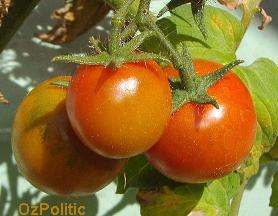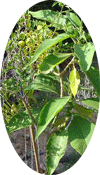|
Tomatoes
Previous
Next
Up
Home
Solanum lycopersicum cerasiforme

Tomatoes are harder to grow, especially if there are any hungry brushtail possums around. Cherry tomatoes are probably the easiest of the bunch. You can get tomato seedlings coming up in your mulch from the seeds of tomatoes you got from the supermarket. I am growing most of my tomatoes in a bathtub with a birdmesh cage on top to keep out the possums, scrub turkeys and other birds. This also helps to save on water.
Many people recommend that you remove all the side stems from a tomato bush. This seems to increase the size of the leaves and the fruit, and makes the fruit ripen faster. You get a few larger fruit spread out in time, rather than a big crop of small fruit just before the bush dies. You can use these stems for grafting, or simply plant them in the soil. If you keep the soil moist enough they will grow.
 Special feature: an illustrated guide to grafting tomatoes and eggplant onto wild tobacco. Special feature: an illustrated guide to grafting tomatoes and eggplant onto wild tobacco.
A cherry tomato is a smaller garden variety of tomato. It is marketed at a premium to ordinary tomatoes, and is popular as a snack and in salads. Cherry tomatoes are generally considered to be similar but not identical to the wild precursor of the domestic tomato. They are often sweeter than standard tomatoes.
Cherry tomatoes range in size from a thumbtip up to the size of a golf ball, and can range from being spherical to slightly oblong in shape. The more oblong ones often share characteristics with plum tomatoes, and are known as grape tomatoes.
The cherry tomato has 24 chromosomes, and its scientific name is Solanum lycopersicum cerasiforme.
There are a number of cherry tomato varieties. The Santorini cherry tomato is cultivated in Santorini (Greece), and is known for its flavour and body. International conferences dedicated to the cultivation, horticulture and agriculture of the cherry tomato are also held at Santorini. Another popular variety often grown in American gardens is Sweet 100, named for its flavour and prolific production.
List of tomato cultivars
The number after each variety is the days to maturity. See below for more terms.
Indeterminate
Red
Ace 55 -- 80 days -- VF -- heirloom -- super-low acidity
Amish Paste -- 85 days -- heirloom -- As the name implies, best for paste/sauce and bred originally by the Amish. Oblong shape, good taste
Beefsteak - 90 days -- heirloom -- archetypical broad, lobed variety
Beefmaster -- 80 days -- hybrid -- purportedly the very best version of beefsteak
Better Boy -- 82 days -- hybrid -- improved version of the original Big Boy
Celebrity -- 70 days -- VA -- hybrid
Crimson Cushion -- 90 days -- heirloom -- large, ribbed, wilt-resistant
Delicious -- 77 days -- heirloom -- 16oz fruit, few seeds
Earliana -- 65 days -- heirloom -- 6oz fruit, introduced in 1900
Early Girl -- 52 days -- VF -- hybrid -- Very early, smooth round/oval fruit in the 6oz range
Goliath -- 85 days -- heirloom -- largest known tomato, up to 48 ounces!
Liz Birt -- 75 days -- OP -- medium to large sweet fruits with a more pronounced acid taste, derived from 'Brandywine' X 'Cherokee Purple'
Matchless -- 85 -- heirloom -- 6oz fruit, created by W. Atlee Burpee in 1889
Moneymaker -- 80 -- heirloom -- 5oz fruit
Monkey's Ass -- 80 -- large red fruit divided into two lobes on one side, ergo the name
Mortgage Lifter -- 85 -- beefsteak fruit, its creator sold plants to pay off his mortgage
Red Brandywine -- 100 days -- heirloom -- Amish origins -- PL
Roma Tomato -- 85 days -- heirloom -- THE standard paste tomato, pear-shaped, from Italy
Super Fantastic -- 70 days -- VF -- hybrid -- heavy producer of large, smooth, round fruit with a good balance of sweet and acidic.
Three Sisters -- 75 days -- 6oz fruit -- Potato leaf -- This breed actually can bear any one of three types of tomato: A single-pleated variety, a roma style, or a pleated, flattened fruit.
Pink
Brandywine -- 90 days -- heirloom -- Amish origins -- PL
Giant belgium pink -- 85 days -- 32 oz fruit! Low acid, sweet
Pink beefsteak -- 70 days -- as the name implies, medium beefsteak variety, even more pink than typical beefsteaks
Violaceum Krypni-Rozo -- 80 days -- heirloom -- bizarre 8oz scalloped fruit, extremely deep and numerous lobes has a pretty, unique style
Orange
Amana Orange -- 90 days - 16oz, beefsteak-style fruit is orange, has a mild flavour
Yellow
Garden peach tomato -- 80 days -- yellow fruit has fuzzy skin, and is yellow, therefore resembles a peach
Yellow Brandywine -- 100 days -- heirloom -- Amish origins -- PL
Black / purple
Aunt Ginny's Purple -- 80 days -- flavour is said to be similar to brandywine, though it produces more
Bear Creek -- early-midseason -- large attractive fruits of fine flavour and good production, named for Bear Creek Farm in Osceola, Mo
Black Krim -- 80 days -- 12oz fruit, dark purple with green shoulders
Black Russian -- 75 days -- pretty, plentiful small black fruit
Cherokee purple -- 80 days -- 16oz fruit with purple shoulders, originally grown by Cherokee Indians
Chocolate cherokee -- 80 days -- crimson with brown/black shoulders
Dora -- 80-85 days -- large beefstake type fruits developed solely for flavour, regular leaf
Gary O' Sena -- 70-75 day -- large pink purple fruits, potato leafed, developed from Brandywine x Cherokee Purple
Green
Aunt Ruby's German Green -- 80 days -- beefsteak style, 16oz fruit
Emerald Evergreen -- 72 days -- Supposedly especially good and mild tasting
Green Bell Pepper -- 76 days -- not actually a green pepper, but shaped and coloured like one, inside and out. Tastes like a tomato.
White
White wonder -- 80 days -- 32oz fruit, huge and yellowish white
Multicolour
Black Zebra -- 85 days -- brown with black stripes, deep, sweet flavour
Green Zebra -- 78 days -- 4oz fruit with two tone green stripes
Mister Stripey -- 56 days -- early, 6 oz, beefsteak-style fruit is yellow with red/pink stripes, fun
Dwarf indeterminate, semi-indeterminate, tree-type, et cetera
Red
Extreme Bush -- 50 days -- heavy producers, extended season determinate
Pink
Dwarf champion -- 80 days -- 8oz fruit
New Big Dwarf -- 90 days -- 16oz fruit, been around 90 years, illustrating why you should never name anything "New..."
Yellow
Azoychka -- 60 days -- 8oz fruit, yellow inside and out
Determinate
Red
Cherokee -- VF -- 80 days -- Not related to Cherokee Purple
Marglobe -- VF -- 75 days -- large fruit, fewer spaces and seeds
Rutgers -- 75 days -- heirloom -- 6oz fruit, crack resistant
Disease resistant abbreviations
V = Verticillium wilt
N = Nematodes
F = Fusarium Wilt
FF = Fusarium, races 1 & 2
A = Alternaria stem canker
T = Tobacco Mosaic Virus Resistant
Indeterminate growth
In biology and especially botany, indeterminate growth refers to growth that is not terminated in contrast to determinate growth that stops once a genetically pre-determined structure has completely formed. Thus, a plant that grows and produces flowers and fruit until killed by frost or some other external factor is called indeterminate. For example, the term is applied to tomato varieties that grow in a rather gangly fashion, producing fruit throughout the growing season, and in contrast to a determinate tomato plant, which grows in a more bushy shape and typically produces a single harvest. In reference to an inflorescence (a shoot bearing flowers), an indeterminate type (such as a raceme) has the flowers developing and opening from the base towards the growing tip. The growth of the shoot is not impeded by the opening of the early flowers or development of fruits and its appearance is of growing and producing flowers indefinitely. In a determinate inflorescence, typically all of the flower buds are formed before the first ones begin to open, and all open more or less at the same time; or a terminal flower blooms first and stops elongation of the main axis.
| 
 Special feature:
Special feature: